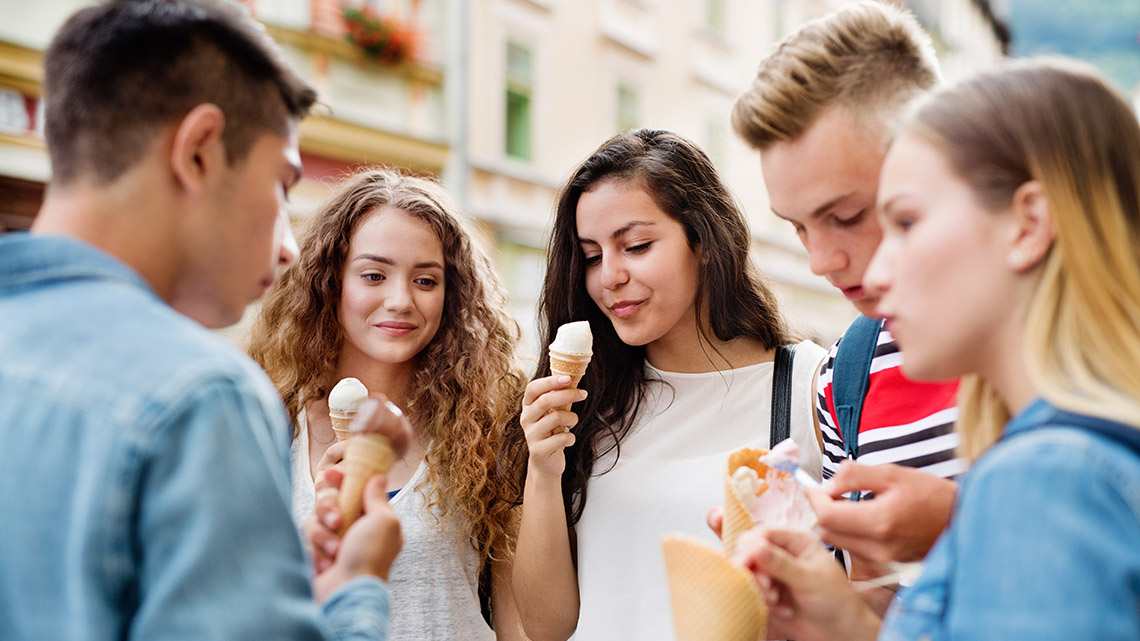Minds On
Ice cream sundae bar

Explore all of the options at the Ice Cream Sundae Bar.
|
Ice Cream Flavours |
Toppings |
Sauce |
|---|---|---|
|
Vanilla |
Sprinkles |
Caramel |
|
Chocolate |
Chocolate Chips |
Fudge |
|
Oreo |
Nuts |
Strawberry |
|
Cookie Dough |
Gummy Bears |
Butterscotch |
- Can you determine all of the possible outcomes selecting one item from each of the three columns?
- What are some ways to organize all of the possible outcomes?
- How might you calculate the probability of getting chocolate ice cream with nuts and fudge?
Throughout this learning activity, you can record your ideas digitally, orally, or in print.
Action
Task 1: Tree diagrams
Tree diagrams are an effective way to organize all of the possible combinations of outcomes.
A tree diagram is a branching diagram that shows all possible combinations or outcomes for two or more independent events.
Examine the following tree diagram for the probability of one of two options to occur.
There are two “branches” (one for Option 1 and another one for Option 2)
- The probability of each branch is labelled on the branch (0.5 or 50% probability)
- The outcome is labelled at the end of the branch.
We can extend the diagram to calculate the probability of the two options. The previous diagram is extended to show two more branches coming out from Option 1 and two more branches coming out from Option 2.
- The probability for each branch is labelled on the branch (0.5 or 50% probability)
- The outcome is labelled at the end of the branch: Option 1, or Option 2
- The first branch is Option 1, Option 1 and Option 1, Option 2
- The second branch is Option 2, Option 1 and Option 2, Option 2
How do we calculate the overall probabilities?
- We multiply probabilities along the branches.
- We add probabilities down the columns.
The previous diagram is used to indicate that you can multiply probabilities along the branches and add probabilities down columns.
Now we can notice such things as:
- The probability of Option 1 occurring twice in a row is 0.5 × 0.5 = 0.25.
- All probabilities add to 1.0 or 100%.
- The probability of getting Option 1 at least once in two tosses is 0.25 + 0.25 + 0.25 = 0.75.
Your turn!
Examining the table from Minds On, we notice that each ice cream flavour has four possible topping combinations, followed by four possible sauces. As each choice is added, the total number of possible outcomes increases.
|
Ice Cream Flavours |
Toppings |
Sauce |
|---|---|---|
|
Vanilla |
Sprinkles |
Caramel |
|
Chocolate |
Chocolate Chips |
Fudge |
|
Oreo |
Nuts |
Strawberry |
|
Cookie Dough |
Gummy Bears |
Butterscotch |
All of the possible outcomes can be organized in a tree diagram that we can use to calculate the probability of each outcome.
- Create a tree diagram digitally or on paper, or a chart to organize all possible outcomes at the Sundae Bar.
- Calculate the probability of getting:
- Chocolate Ice Cream with Nuts and Fudge.
- Oreo Ice cream with Sprinkles (and any sauce).
- Vanilla ice cream (and any topping and sauce)
Task 2: Sample space diagrams
Sample space diagrams are a way of recording all of the possible outcomes for two events.
The table in the following document shows the possibilities when two coins are flipped:
|
First Coin |
|||
|---|---|---|---|
| Heads | Tails | ||
|
Second Coin |
Heads |
(Head, Head) |
(Tail, Head) |
|
Tails |
(Head, Tail) |
(Tail, Tail) |
|
The probability of flipping a Head, followed by a Tail is because flipping a Head, followed by a Tail only appears once in the sample space diagram and there are 4 outcomes in total.
The probability of flipping a Head and a Tail is 2 out of 4, or , or or 50%.
This is because to flip a Head and a Tail, we can have either the outcome of flipping a Head first then a Tail, or the outcome of flipping a Tail and then a Head.
- What is the probability of flipping Tails twice in a row? How do you know?
- What is the probability of flipping Heads twice in a row? How do you know?
- What is the probability of flipping a Tail then a Head? How do you know?
- What is the probability of flipping a Head then a Tail? How do you know?

Task 3: Sample space - set notation
A sample space is the list of all possible outcomes for an event.
We could record the sample space in set notation, which is represented by listing all of the possible outcomes in {curly brackets}.
For example, recording the possible outcomes for rolling a die, or pressing a button that provides the options aloud and in writing, in set notation is: {1, 2, 3, 4, 5, 6}.
Your turn!
What would be the possible outcomes for flipping a coin or pressing a button that provides the options aloud and in writing, in set notation?
Press ‘Answer’ to reveal the answer to the question.
Task 4: Sample space - counting principle
What if we wanted to know the possible outcomes for flipping a coin and rolling a die, or pressing a button that provides the option aloud and in writing?
The counting principle states that if one event has m possible outcomes and a second independent event has n possible outcomes, then there are m × n total possible outcomes for the two events to happen together.
Use the counting principle to determine the total possible outcomes of the events.
Let’s do this together, step by step. Press ‘Answer’ to check each step.
Number of possible outcomes for flipping a coin: m = ?
Number of possible outcomes for rolling a six-sided die: n = ?
m × n = total number of possible outcomes for the two events to happen together. Plug in the values for m and n to determine the total possible outcomes.
2 × 6 = 12 possible outcomes
The set notation for these two combined events is {H1, H2, H3, H4, H5, H6, T1, T2, T3, T4, T5, T6} or 12 possible outcomes.
Your turn!
Use the counting principle to determine the total possible number of outcomes in one of these examples. Record your thoughts in an audio recording, on paper, or on a computer.
- Example 1: Choosing one of the following: rock, marble, eraser, flower, trees, or bush.
- Example 2: Choosing an outfit (pants and shirt and shoes) when you have 4 pairs of pants, 5 shirts, and 2 pairs of shoes.
Consolidation
Task 1: Rolling two dice
- Create either a tree diagram or a sample space diagram for rolling two dice. Your diagram can be created digitally, on paper, or using concrete materials.

- Determine how many total possible outcomes there will be using the appropriate method for the diagram of your choice. The dice or digital dice option contain the values one to six.
- What is the probability of getting a 3, 2 in that order? Explain why. Record your ideas using a method of your choice.
- What is the probability of getting a 3 and a 2? Explain why.
Task 2: Independent practice

Think of an example of two independent events. Make a tree diagram to determine and compare the theoretical and experimental probabilities of the two independent events happening. You can create your diagram digitally, on paper, or using concrete materials.
Reflection
As you read the following descriptions, select the one that best describes your current understanding of the learning in this activity. Press the corresponding button once you have made your choice.
I feel…
Now, expand on your ideas by recording your thoughts using a voice recorder, speech-to-text, or writing tool.
When you review your notes on this learning activity later, reflect on whether you would select a different description based on your further review of the material in this learning activity.
Connect with a TVO Mathify tutor
Think of TVO Mathify as your own personalized math coach, here to support your learning at home. Press ‘TVO Mathify’ to connect with an Ontario Certified Teacher math tutor of your choice. You will need a TVO Mathify login to access this resource.
TVO Mathify (Opens in new window)